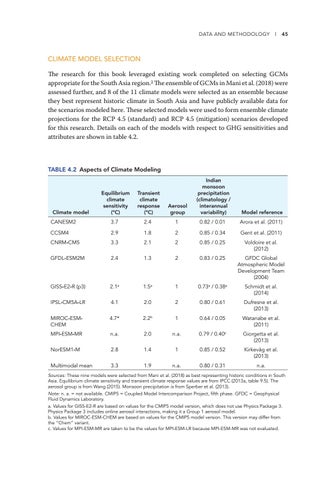Data and Methodology l 45
CLIMATE MODEL SELECTION The research for this book leveraged existing work completed on selecting GCMs appropriate for the South Asia region.3 The ensemble of GCMs in Mani et al. (2018) were assessed further, and 8 of the 11 climate models were selected as an ensemble because they best represent historic climate in South Asia and have publicly available data for the scenarios modeled here. These selected models were used to form ensemble climate projections for the RCP 4.5 (standard) and RCP 4.5 (mitigation) scenarios developed for this research. Details on each of the models with respect to GHG sensitivities and attributes are shown in table 4.2.
TABLE 4.2 Aspects of Climate Modeling
Climate model CANESM2
Equilibrium climate sensitivity (°C)
Transient climate response (°C)
Aerosol group
Indian monsoon precipitation (climatology / interannual variability)
3.7
2.4
1
0.82 / 0.01
Arora et al. (2011)
Model reference
CCSM4
2.9
1.8
2
0.85 / 0.34
Gent et al. (2011)
CNRM-CM5
3.3
2.1
2
0.85 / 0.25
Voldoire et al. (2012)
GFDL-ESM2M
2.4
1.3
2
0.83 / 0.25
GFDC Global Atmospheric Model Development Team (2004)
GISS-E2-R (p3)
2.1a
1.5a
1
0.73a / 0.38a
Schmidt et al. (2014)
IPSL-CM5A-LR
4.1
2.0
2
0.80 / 0.61
Dufresne et al. (2013)
MIROC-ESMCHEM
4.7*
2.2b
1
0.64 / 0.05
Watanabe et al. (2011)
MPI-ESM-MR
n.a.
2.0
n.a.
0.79 / 0.40c
Giorgetta et al. (2013)
NorESM1-M
2.8
1.4
1
0.85 / 0.52
Kirkevåg et al. (2013)
Multimodal mean
3.3
1.9
n.a.
0.80 / 0.31
n.a.
Sources: These nine models were selected from Mani et al. (2018) as best representing historic conditions in South Asia. Equilibrium climate sensitivity and transient climate response values are from IPCC (2013a, table 9.5). The aerosol group is from Wang (2015). Monsoon precipitation is from Sperber et al. (2013). Note: n. a. = not available. CMIP5 = Coupled Model Intercomparison Project, fifth phase. GFDC = Geophysical Fluid Dynamics Laboratory. a. Values for GISS-E2-R are based on values for the CMIP5 model version, which does not use Physics Package 3. Physics Package 3 includes online aerosol interactions, making it a Group 1 aerosol model. b. Values for MIROC-ESM-CHEM are based on values for the CMIP5 model version. This version may differ from the “Chem” variant. c. Values for MPI-ESM-MR are taken to be the values for MPI-ESM-LR because MPI-ESM-MR was not evaluated.




